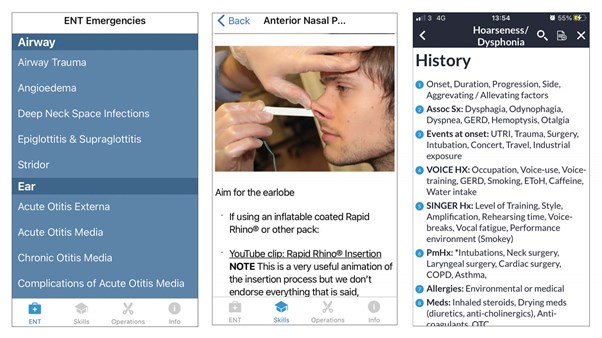ENT apps for trainees are few and far between. Here are a couple of them which could be useful for the on-call.
ENTSHO.com
![]() Born out of the website with the same name, this app is a must-have if you work in a trust with bad internet connection or if you just don’t want to be caught Googling ‘where is the mastoid’ on a large desktop monitor in A+E (is it only me that gets embarrassed about this?).
Born out of the website with the same name, this app is a must-have if you work in a trust with bad internet connection or if you just don’t want to be caught Googling ‘where is the mastoid’ on a large desktop monitor in A+E (is it only me that gets embarrassed about this?).
If you haven’t heard of this website, then you’re in for a treat. This is probably the best resource I’ve found that tackles the majority of things you may come across during an on-call ENT shift. It is practical, incredibly useful, written by ENT trainees, and checked by an ENT senior before publication onto the website. It is also delightfully up to date. I was pleased to find that the app contains all of the same information, whilst having the additional bonus of being accessible offline.
“This is probably the best resource I’ve found that tackles the majority of things you may come across during an on-call ENT shift”
The app itself has a simple design that works perfectly, with a treasure trove of key ENT content. A few topics to whet your appetite are assessing and managing an airway trauma (including when to escalate to a senior), how to assess and drain a quinsy, how to conduct flexible nasendoscopy, and what the indications, risks, and postop complications are for a tracheostomy (and how to deal with them).
Positives:
- Covers the majority of problems faced during the ENT on-call.
- Explanations enhanced by diagrams, pictures, or video hyperlinks.
- Concise information.
Negatives:
- Paid app.
Learn ENT
![]() This has been previously covered by ENT & Audiology News in 2015 [1], however it needs to be mentioned again in this list. Branded the official learning app of the Canadian Society of Otolaryngology – Head and Neck Surgery, this app has a lot to live up to. With that said, it largely delivers. As an app, it also does the most out of any of the others, embedding videos, pictures, quizzes, and editable notes for different sections. It has also undergone a few design changes since our last review.
This has been previously covered by ENT & Audiology News in 2015 [1], however it needs to be mentioned again in this list. Branded the official learning app of the Canadian Society of Otolaryngology – Head and Neck Surgery, this app has a lot to live up to. With that said, it largely delivers. As an app, it also does the most out of any of the others, embedding videos, pictures, quizzes, and editable notes for different sections. It has also undergone a few design changes since our last review.
Regarding the content, there is information here for both junior and senior ENT trainees, with sections starting from basic (e.g. head and neck examination instructions, and accompanying video), to more specialised material (e.g. various classification systems for diseases, cancer staging and neck dissection steps and anatomy). For the SHO on call however, the most useful section can be found under ‘approach to common problems’, where very comprehensive assessment, work-up and management sections are documented for a range of presenting complaints. Unlike the ENTSHO app, Learn ENT requires internet access at the time of usage.
Positives:
- Useful for ENT trainees at different levels of training.
- Useful for the on-call, and for clinic, theatre or general learning.
Negatives:
- A few of the sections are a bit sparse.
- Some sections are quite long and take a while to load if your internet speed is poor.

ENT UK
![]() This uses a third-party app to run, and so can be downloaded by following the instructions at www.entuk.org/ent-uk-app-released. The app is essentially a phone-friendly version of the website, with all the same information, and so has not primarily been created for the on-call ENT trainee. With that said, it receives an honourable mention as the clinical guidelines section is extremely strong, presenting information in a flow-diagram that automatically cuts out the less essential information that isn’t needed during the on-call shift, and highlights the important red flags and management steps.
This uses a third-party app to run, and so can be downloaded by following the instructions at www.entuk.org/ent-uk-app-released. The app is essentially a phone-friendly version of the website, with all the same information, and so has not primarily been created for the on-call ENT trainee. With that said, it receives an honourable mention as the clinical guidelines section is extremely strong, presenting information in a flow-diagram that automatically cuts out the less essential information that isn’t needed during the on-call shift, and highlights the important red flags and management steps.
“The clinical guidelines section is extremely strong, presenting information in a flow-diagram that automatically cuts out the less essential information that isn’t needed during the on-call shift”
There is also a ‘conditions and procedures’ section that contains good nuggets of information about percentage risks for operations which could come in handy when consenting.
Positives:
- Simple, high-yield flowchart diagrams for various guidelines, such as sudden hearing loss.
Negatives:
- Limited number of clinical guidelines.• Some guidelines require ENT UK membership login.
SeeENT
![]() Although not helpful clinically, this app is full of different ENT-relevant diagrams that can be zoomed in, drawn on, or edited with different colours to help explain a procedure, finding, or concept to a patient.
Although not helpful clinically, this app is full of different ENT-relevant diagrams that can be zoomed in, drawn on, or edited with different colours to help explain a procedure, finding, or concept to a patient.
E-i pro
![]() Similar to above, this app does not directly help with the on-call, but allows for endoscopic findings to be recorded on your phone which can then be shown to the patient or a colleague for a second opinion, and/or saved into the patient’s records (dependent on the trust’s data protection and confidentiality protocol). An adaptor needs to be purchased separately from the endoscope-i website - https://shop.endoscope-i.com/.
Similar to above, this app does not directly help with the on-call, but allows for endoscopic findings to be recorded on your phone which can then be shown to the patient or a colleague for a second opinion, and/or saved into the patient’s records (dependent on the trust’s data protection and confidentiality protocol). An adaptor needs to be purchased separately from the endoscope-i website - https://shop.endoscope-i.com/.
Conclusion
Although there are limited apps for ENT trainees, a handful of them have the potential to make the on-call more manageable.

Reference
1. Pothier D, Falls C. LearnENT app – bringing otolaryngology to your mobile. ENT & Audiology News 2015:23(6).96.
Declaration of competing interests: Chris Coulson is director of endoscope-i, but was not involved in the selection or review of the e-i pro app in this article.





